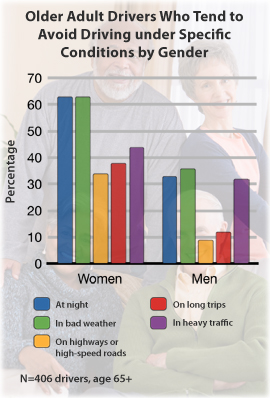New Data on Older Drivers
Driving helps older adults stay mobile and independent, but the risk of being injured or killed in a motor vehicle crash increases as people age.
 Driving helps older adults stay mobile and independent. But the risk of being injured or killed in a motor vehicle crash increases as people age. In 2008, more than 5,500 older adults were killed in motor vehicle crashes and more than 183,000 were injured. This amounts to 15 older adults killed and 500 injured in crashes on average every day.
Driving helps older adults stay mobile and independent. But the risk of being injured or killed in a motor vehicle crash increases as people age. In 2008, more than 5,500 older adults were killed in motor vehicle crashes and more than 183,000 were injured. This amounts to 15 older adults killed and 500 injured in crashes on average every day.
A recent survey of adults ages 65 or older explored reasons why older adults limit, or self-restrict, their driving during certain conditions (e.g., at night or in bad weather) and reasons why some older adults stop driving altogether. Of the 479 people surveyed, 406 respondents were current drivers, and 73 reported that they no longer drive. Of the current drivers, about 57% of men and 81% of women reported that they avoided driving under certain conditions. Respondents most commonly limited their driving at night and in bad weather. One-third of older men and two-thirds of older women stated that they avoided driving under each of these conditions.
Other findings included:
- Only 9% of older men, but 34% of older women, reported avoiding driving on highways or high-speed roads.
- A third of older men and 44% of older women reported avoiding driving in heavy traffic.
- About 10% of older men and 15% of older women reported cutting back on driving due to a physical problem in the last year.
- Of those that cut back on driving due to physical problem, 40% cited vision-related issues as a reason.
Tips to Stay Safe
If you are a driver age 65 or older, you can make your time behind the wheel safer by:
- Asking your doctor or pharmacist to review your medicines (both prescription and over-the counter) to reduce possible side effects and drug interactions.
- Having your eyes checked by an eye doctor at least once a year, and wearing your glasses and contact lenses as required.
- Planning your route before you drive.
- Leaving a large following distance behind the car in front of you.
- Avoiding distractions in your car, such as listening to a loud radio, talking on your cell phone, texting, and eating.
- Considering potential alternatives to driving, such as riding with a friend or using public transit, that you could use to get around.
More Information
CDC Resources
External Resources
- University of Michigan, Transportation Research Institute
- AAA Foundation for Traffic Safety
- AAA National: AAA Roadwise Review
- National Highway Traffic Safety Administration
- Community Transportation Association of America
Get email updates
To receive email updates about this page, enter your email address:
Contact Us:
- Centers for Disease Control and Prevention
1600 Clifton Rd
Atlanta, GA 30333 - 800-CDC-INFO
(800-232-4636)
TTY: (888) 232-6348 - Contact CDC-INFO



